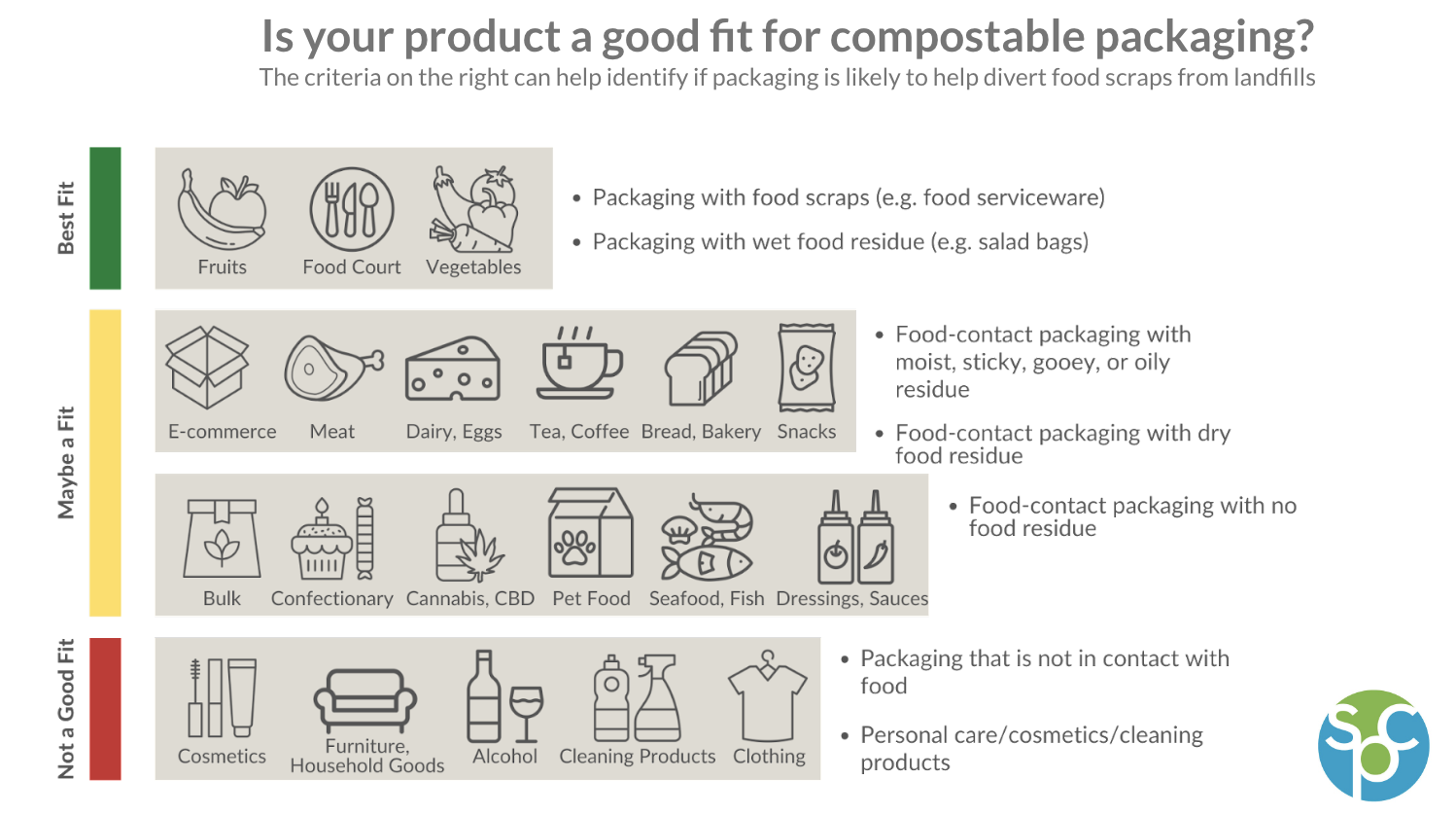Also check out our Sustainability Terms Glossary, where we’ll add key terms from each of our Deep Dives over time. Bookmark this page for future reference!
In Part 1 of this series, we discussed how the term “bioplastics” can refer to many different things, including (but not limited to) biodegradable or compostable plastics. In Part 2, we dove into the difference between “biodegradable” and “compostable,” what happens in a composting environment, and the compostability certifications. In Part 3 of this series, we’ll cover the appropriate uses of compostable packaging.
When does it make sense to use compostable packaging?
The primary reason to use compostable packaging is to help deliver food waste and other organic matter to composting facilities. Food waste in landfills is one of the main sources of methane, a powerful greenhouse gas that has about 20-80 times the power of carbon dioxide. Diverting food waste from landfills is a key intervention to limiting climate change, and compostable packaging can help do that by being the “vehicle” that food scraps ride along with on their way to composting facilities. Composting facilities that accept compostable packaging are able to bring in more food waste than those that don’t.
Compostable packaging should be reserved for packaging that is:
- Used to serve prepared food or contains frozen or raw food
- Likely to deliver food to a composting facility
- Food-contact packaging that is not readily recyclable
- Often disposed of with food waste (e.g., produce stickers)
- Fiber-based and is likely to become food-soiled
When should we not use compostable packaging?
Compostable packaging should not be used for the following applications, with some exceptions:
A package that can be made of easily recycled materials
Recycling beats composting both from an accessibility and circularity point of view. From an access perspective, about 91% of U.S. residents have access to recycling,i whereas only about 11% of the U.S. population has access to a composting program that accepts compostable packaging.ii From a circularity standpoint, in a truly circular economy, materials are kept at their “highest and best use” for as many cycles as possible. This means, if possible, keeping a material functioning in close to its current state without having to “downcycle” it. For example, a PET bottle serves its highest and best use if it’s turned into a PET bottle again, rather than being downcycled into another unrecyclable product. Similarly, paper can be recycled to make paper again, and while composting it is often an option, recycling it to make new paper keeps it at its highest and best use for longer.iii
Packaging that is part of a suite of recyclable packaging products
Our goal is to make decisions as easy as possible for consumers when they’re discarding a set of packaging. The ideal packaging system is either entirely recyclable or entirely compostable. If the package system has a mix of both recyclable and compostable items, it is less convenient for consumers to separate items. For example, an e-commerce shipment that comes in a cardboard box ideally just has curbside-recyclable packaging inside so that the consumer can place all items (box, void fill, etc.) in the recycling bin. Another example would be food-service ware that’s entirely compostable. Ideally, a clamshell tray, napkins, and cutlery would all be compostable so the consumer can place everything in one bin.
Packaging not used for food, or packaging for personal care, cleaning products, or cosmetics
Packaging for non-food purposes doesn’t increase the amount of food waste diverted to composters. Additionally, leftover product inside (like residues from cleaning products or cosmetics) may not be safe for compost since it will someday be soil. Some composters have raised the issue that if packaging for a lot of non-food items is designed to be compostable then they’ll receive too much packaging relative to food. For example, if poly bags for garments are replaced at scale with compostable options, the influx of compostable plastic may throw off the composters’ chemical balances at their facilities. They ultimately want mostly food and yard trimmings and just some packaging.

I have a good use case for compostable packaging. What else should I know?
If the right end-of-life pathway for packaging is composting, consider:
If the package can be made of fiber, rather than bioplastics, fiber is probably better.
Most composting facilities find it easier to deal with fiber than they do with bioplastics. Not all of them can produce the conditions necessary to break down bioplastics, even those that are certified compostable. Others choose not to accept bioplastics because they wind up receiving non-compostable plastics as well, which contaminate the compost. Additionally, fiber-based compostable packaging can be a useful source of carbon in the composting process. Carbon is an important ingredient to making compost.
Compostable packaging should be certified by one of the below bodies or tests:
- BPI Compostable – used for compostable foodservice packaging
- TUV Austria OK Compost (either “HOME” or “INDUSTRIAL”)
- ASTM D6400 or ASTM D6868 (more common in the U.S.)
- EN 13432 (more common in Europe)
For more information on compostability certifications, check out the previous Deep Dive in this series!
Compostable packaging should be clearly marked to prevent contamination.
Compostable packaging only turns to compost if it’s composted. Compostable packaging should be marked clearly to instruct consumers to find an outlet to compost it. It should also include any applicable certifications on the package.
i Sustainable Packaging Coalition, “2020-2021 Centralized Study on Availability of Recycling.” This number represents the “US residents [who] have access to either curbside and/or drop-off recycling programs that accept packaging materials.”
ii Sustainable Packaging Coalition (2021), “Understanding the Role of Compostable Packaging in North America.”
iii For more information, see the Ellen MacArthur Foundation’s page on this principle: https://ellenmacarthurfoundation.org/circulate-products-and-materials
